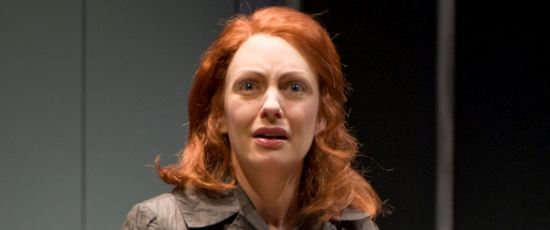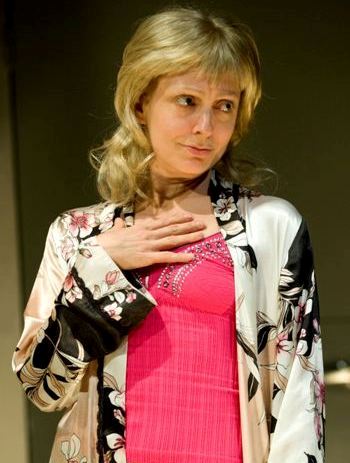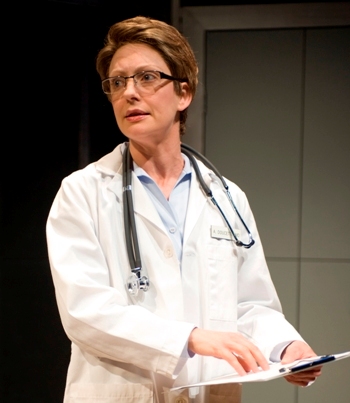Unveiling truth in ‘Blonde, Brunette, Redhead’ in more ways than meet the hoodwinked eye
 Review: “The Blonde, the Brunette and the Vengeful Redhead” by Robert Hewett, at Writers’ Theatre through July 29. ****
Review: “The Blonde, the Brunette and the Vengeful Redhead” by Robert Hewett, at Writers’ Theatre through July 29. ****
By Lawrence B. Johnson
Each time I see “The Blonde, the Brunette and the Vengeful Redhead,” Australian playwright Robert Hewett’s stunning one-woman turn about betrayal, redemption and the bizarre ways in which disparate lives can intersect, I’m struck again by the disconnect between this dark drama and its almost comedic title.
What might sound like a wacky romp is in fact a stark tragedy, one involving ordinary people – seven, by the way, not three, and they are all brought disarmingly to life in Deborah Staples’ multi-personality performance at Writers’ Theatre.
 A veteran member of the Milwaukee Repertory Theatre, where she immersed herself in the characters of “Vengeful Redhead,” Staples does what I suspect could not be done better by seven different actors: She embodies each of Robert Hewettt’s deftly sketched characters as if it were her night’s only assignment, summoning seven different, invested perspectives on one horrific event that affects all of them and enthralls the viewer as well.
A veteran member of the Milwaukee Repertory Theatre, where she immersed herself in the characters of “Vengeful Redhead,” Staples does what I suspect could not be done better by seven different actors: She embodies each of Robert Hewettt’s deftly sketched characters as if it were her night’s only assignment, summoning seven different, invested perspectives on one horrific event that affects all of them and enthralls the viewer as well.
Rhonda – the vengeful redhead – is, to begin with, the furthest thing from a mayhem-prone crazy lady. She’s a garden variety housewife and mother, a suburbanite soccer mom married to a guy who alters her life one day when he calls from the office to say he’s leaving her. Good-bye, that’s it, I’m done with you and I ain’t comin’ back no more. (That, as we will discover, could be verbatim what Rhonda heard on the phone.)
It turns out hubby has been quite publicly intimate with a Russian blonde who works at a jewelry store at the nearby mall – or so says Rhonda’s next door neighbor and good pal Lynette, the brunette in this mélange. Lynette, who swears she would never interfere in another person’s private affairs and would only reveal this because she’s Rhonda’s very good friend – honest to God – informs Rhonda that she saw the blonde and Rhonda’s man tongue-kissing at a fast-food joint. (Lynette also has seen this floozy working at the jewelry store.)
 Rhonda, urged – maybe the right word is egged – on by her dear friend, springs into hysterical pursuit of the home-wrecking blonde, with devastating consequences for several people, not least for Rhonda.
Rhonda, urged – maybe the right word is egged – on by her dear friend, springs into hysterical pursuit of the home-wrecking blonde, with devastating consequences for several people, not least for Rhonda.
But let’s go back to square one, with Rhonda, whom we first meet in the immediate aftershock of her husband’s phoned-in exit. She’s all aflutter, distracted – whining, the truth to tell. Not, I confess, the most appealing character, a real fingernails on the blackboard personality. You might wonder, where can this go?
Then, snap: Scene I ends, Deborah Staples steps over to a make-up station, rearranges herself before our eyes and returns to center stage as neither redhead, blonde nor brunette. She’s a middle-aged physician, with a curious tale to tell about this guy who has come in looking for sedatives, upset about his marriage tanking.
The doc is a lesbian whose partner fills her life with joy and solace. She has a doctor’s manner of speaking, analytical and precise, but she also expresses a great passion for life and faith in the meaning of her work. She could be a motivational speaker. She also tells us about various forms and grades of trauma to the skull.
 What a contrast with the brunette, Rhonda’s bubbly neighbor Lynette. Real thought never impinges on the broad, endless stream of her discourse. She says she understands people, notices things. She says she never meddles. She styles herself as the best possible neighbor, and a true friend.
What a contrast with the brunette, Rhonda’s bubbly neighbor Lynette. Real thought never impinges on the broad, endless stream of her discourse. She says she understands people, notices things. She says she never meddles. She styles herself as the best possible neighbor, and a true friend.
And the blonde, the Russian? From her we hear about this guy, you would not believe what he did. She’s been around and she can tell you: things are not always the way they appear.
Each of these distinctive characters, and a frail old lady who sees a lot from her front porch and can make a piece of hard candy last all day, Stables draws with a portaitist’s mastery, down to the light and shadow that sorts out the life textures of one from another. All very fine, though all women.
 More remarkable is the actor’s extended scene as Rhonda’s low-life husband, ruminating on the turn things have taken as he pulls on a beer. This is where an actress can veer off course, but not Staples. She has this narcissistic jerk by the – well, she has him down: vulgar, self-serving, oblivious. Tragedy? He doesn’t even see a problem.
More remarkable is the actor’s extended scene as Rhonda’s low-life husband, ruminating on the turn things have taken as he pulls on a beer. This is where an actress can veer off course, but not Staples. She has this narcissistic jerk by the – well, she has him down: vulgar, self-serving, oblivious. Tragedy? He doesn’t even see a problem.
But best, just beautifully touching is Staples at her hardest task, becoming an emotionally troubled little boy of four and a half. He has a stake in this, too. Staples takes your breath away, then breaks your heart.
Somewhere in this riveting narrative is the invisible hand of director Joseph Hanreddy. Surely actor and director here are like horse and rider, grand in their unity. And though it’s a one-woman show, the ensemble onstage with her is plainly visible in Keith Parham’s expressive lighting, Linda Buchanan’s minimalist set, Martha Hally’s defining costumes, Barry G. Funderburg’s sound design and, not least, Lara Dalbey’s story-telling wigs.
Yet epiphany wears no hairpiece. Self-awareness, as Staples’ becalmed Rhonda discovers, can be just plain astonishing.
Related Links:
- Playwright Robert Hewett says he dashed off the play for a friend who complained about the lack of work for a mature actress: Read about the play’s origin here.
- Deborah Staples is a member of the resident acting company at Milwaukee Rep: Check out the Rep’s upcoming season
- Writers Theatre is planning for a new home: Read about Studio Gang, the Aqua Tower architects who will design it
- Performance location, dates and times: Details at TheatreinChicago.com
Photo captions and credits: Home page and top: Deborah Staples as the abandoned wife Rhonda. Descending: Deborah Staples as her chatty neighbor Lynette, the suspected Russian blonde, the doctor and the candy-sucking old lady. (Photos by Michael Brosilow) Below: Deborah Staples as Rhonda.
Tags: "The Blonde the Brunette and the Vengeful Redhead", Barry G. Funderburg, Deborah Staples, Joseph Hanreddy, Keith Parham, Lara Dalbey, Linda Buchanan, Martha Hally, Robert Hewett

